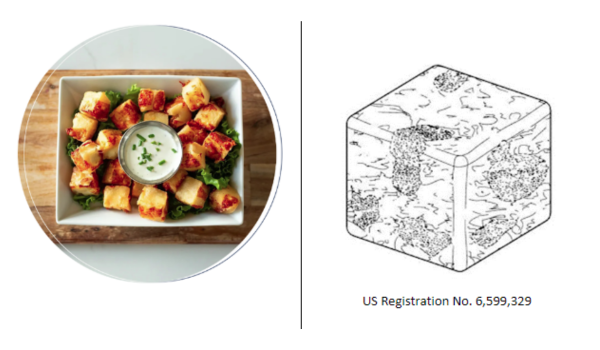07-31-2024 |
It’s Hip To Be Square! But Can You Protect A Square Cheese Curd With IP?
By: Christopher Proskey

As famously said by Huey Lewis: It’s Hip To Be Square!
But that raises the question: Can you protect the shape of a square cheese curd?
Let’s find out!
There is nothing I enjoy more in my career than finding ways to meaningfully protect what is unique about a brand through the use of creative Intellectual Property (“IP”) strategies.
A fun and unique example of #CreativeIP protection, in this case for a food-product, relates to the square shape of cheese curds made by Water’s Edge Cheese Curds.
Water’s Edge Cheese Curds, from, you guessed it, the great cheese fields of Wisconsin (Chippewa Falls to be exact) makes a variety of cheese curds including:
- Yellow Cheddar
- White Cheddar
- Bacon Yellow Cheddar
- Jalapeno Yellow Cheddar
- Ghost Pepper White Cheddar
- Garlic White Cheddar
- Dill Pickle White Cheddar
- Funnel Cake White Cheddar
What is unique about Water’s Edge is that ALL of their cheese curds are made using a proprietary recipe and process that forms perfectly square cheese curds.
Not only are Water’s Edge cheese curds delicious – they are easily distinguishable from every other cheese curd on the market.
In fact, the concept of a “square” cheese curd is a bit of an oxymoron. Cheese curds are formed in an early step of the cheese making process, when milk is allowed to curdle thereby forming the curd – which is inherently irregular and misshapen – and absolutely not-square.
This square shape is emphasized throughout the marketing and branding of Water’s Edge Cheese Curds.
Their logo prominently depicts their square-shaped cheese curds:

(U.S. Registration No. 6,523,773)
They also have a registered trademark for: “The Square Ones!” (U.S. Registration No. 6,523,773).
But can the square shape of a cheese curd be protected? Let’s find out.
TRADEMARK & TRADE DRESS LAW:
Traditionally trademark law has been used to protect a unique name or logo of a company, product or service.
When a company owns a trademark, they can prevent anyone else from using a similar mark with similar goods and services – which is a very powerful (and very valuable) right. More specifically, the standard for trademark infringement is whether there is a “likelihood of consumer confusion”. This is based on:
(1) the similarity of the marks,
(2) the similarity of the goods and services,
(3) the strength of the marks, and
(4) essentially any other relevant factor.
Over time, trademark law has been expanded to protect more than just names and logos. Trademark law now can be used to protect “Trade Dress”. Trade Dress is the unique visual appearance of a product or its packaging. Said another way, Trade Dress is the unique look and feel of a product or brand.
For the shape of a product to qualify for trade dress protection, the shape must be:
(1) non-functional in nature, and
(2) it must be inherently distinctive.
Said another way, trademarks and trade dress cannot be used to protect functional features or functional aspects of a product or its packaging. And trademarks and trade dress cannot be used to protect features that are not unique or distinctive.
Trade dress protection can be obtained in similar procedural manner as a traditional trademark – by filing an application with the United States Patent and Trademark Office (USPTO). The application goes through an evaluation process and if the trademark is registered, the owner has the presumptive right to be the only one that uses the mark with the goods or services across the entire country – again, a very valuable and powerful right.
EXAMPLES OF TRADE DRESS FOR FOOD PRODUCTS:
There is some historical precedence for the protection of the shape of food products through a trade dress application. One example is Pepperidge Farms’ trademark registration for the shape of their Goldfish crackers.

(U.S. Registration No. 3,290,648)
This goldfish shape certainly qualifies for trade dress protection because the goldfish shape is not functional, and the goldfish shape is very unique and distinguishable. Pepperidge Farms cannot prevent others from making crackers that compete with their goldfish crackers. Pepperidge Farms can, however, use their trademark trade dress registration to prevent others from making crackers in a shape that is similar to their goldfish shaped crackers.
Another example is the shape of Sun Chips:

(U.S. Registration No. 3,293,236)
This wavy-chip shape certainly qualifies for trade dress protection because it is not functional, and the shape is unique and distinguishable. Again, Sun Chips cannot prevent others from making crackers in competition with them. Sun Chips can, however, prevent others from making crackers having a similar wavy shape.
SO CAN A SQUARE CHEESE CURD BE PROTECTED:
As is often the case with trademarks, the only way to know if you can get it registered is by filing it and trying.
It turns out, in the example of Water’s Edge Cheese Curds, the answer is YES! A square cheese curd can be protected by way of a trademark trade dress application. As is shown below, the USPTO allowed registration of a square cheese curd:

(US Registration No. 6,599,329)
This is a great example of #CreativeIP and pushing the limits of trademark law to secure meaningful protection for the unique features of a product or brand.
Huey Louis would be very proud! Indeed, it is “Hip To Be Square!” and the USPTO agrees.
I wonder if Huey likes cheese curds? My guess is that he does.
If you have any questions regarding trademark law or need help with trademark registrations, trademark strategy or trademark litigation, please contact Chris Proskey, Intellectual Property Attorney at the BrownWinick Law Firm.
***Note: This blog post is not endorsed by Huey Louis, there is no connection, sponsorship, approval, or affiliation with Huey Louis.****

